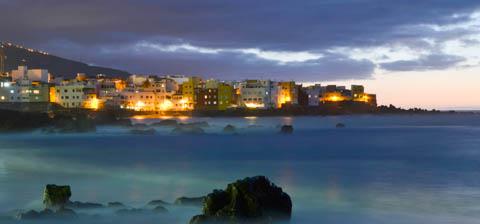Traveling in Canary Islands
 Tenerife Coastline, Canary Islands, Spain
Tenerife Coastline, Canary Islands, Spain
The Canary Islands are a territory of Spain located off the northwest coast of Africa. Made up of rugged volcanic islands, the archipelago is known for its black and white sand beaches with great surf as well as opportunities for hiking, biking, snorkeling, and scuba amongst other activities.
Regions
The Canary chain is made up of the islands of Gran Canaria, Fuerteventura, Lanzarote, Tenerife, La Gomera, La Palma, and El Hierro.
Gran Canaria is the largest island by population, and perhaps has the most varied landscape-green and steep in the north, dry and flat in the south. It is known for its beaches (Playa del Ingles and Maspalomas) and capital city of Las Palmas.
Fuerteventura roughly translates as "Strong Winds" and as this name suggests, is best known for its impressive waves-a surfer's paradise.
Lanzarote has a beautiful volcanic landscape, well-preserved as the Timanfaya National Park on the west part of the island.
Tenerife is the largest of the seven islands, with the highest mountain in Spain, El Teide. Its capital city, Santa Cruz de Tenerife, is home to the Canary Island Parliament and is representative of the region's rich history with many museums and monuments.
La Gomera is marked by deep ravines with cliffs covered in laurel rainforest. The local people have a unique way of communicating across deep ravines by using a whistled speech called Silbo Gomero. This method is indigenous to the island, and its existence has been documented since Roman times.
La Palma is known for its steep volcanic landscapes and terraced countryside interlaced with small towns and villages. The capital of the island, Santa Cruz, has many well-preserved old buildings and cobblestone streets.
El Hierro, also known as the Meridian Island, is the smallest of the Canaries and most western. As a UNESCO World Heritage Site the flora and fauna of the island and its surrounding waters are protected-an ideal place to relax out in nature.

 Budget Your Trip is all about finding out how much everything costs so that you can travel cheaper and longer. Created by avid travelers Laurie and Bryan, our goal is to help you plan your next trip on the right budget. With average daily travel costs that are calculated from the budgets of real travelers, plus an analysis of hotel and tour prices, you can find out how much money you need to plan your next adventure. We also have plenty of travel advice, accommodation reviews, and activity suggestions.
Budget Your Trip is all about finding out how much everything costs so that you can travel cheaper and longer. Created by avid travelers Laurie and Bryan, our goal is to help you plan your next trip on the right budget. With average daily travel costs that are calculated from the budgets of real travelers, plus an analysis of hotel and tour prices, you can find out how much money you need to plan your next adventure. We also have plenty of travel advice, accommodation reviews, and activity suggestions.